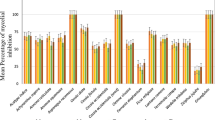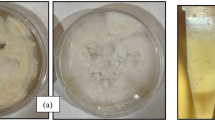Abstract
Dermatophytes are a group of fungal agents that can invade humans’ keratinized tissues such as skin, nail, and hair, thereby causing dermatophyte infection (dermatophytosis) or ringworm. Some natural products have been reported to possess fungicidal effects. Hence, the present study investigated the effect of curcuminoids (CUR) and difluorinated curcumin (CDF) against clinical isolates of dermatophytes. CUR and CDF powders were evaluated against dermatophyte species including Trichophyton tonsurans (n = 21), T. mentagrophytes (n = 19), T. interdigitale (n = 18), Microsporum canis (n = 4), T. benhamiae (n = 1), and T. verrucosum (n = 1), based on the CLSI M38-A2 guideline. The minimum inhibitory concentration (MIC) ranges of CUR were 4–16, 8–16, 4–16, 8, 8, and 16 μg/ml for T. tonsurans, T. mentagrophytes, T. interdigitale, M. canis, T. benhamiae, and T. verrucosum, respectively. In addition, MIC ranges of CDF were obtained as 2–32, 4–16, 0.125–16, 8–16, 8, and 16 μg/ml, for T. tonsurans, T. mentagrophytes, T. interdigitale, M. canis, T. benhamiae, and T. verrucosum, respectively. CUR and CDF showed an inhibitory effect against dermatophyte isolates. CDF showed a stronger effect than CUR, especially against T. interdigitale. CUR and CDF have the capacity to be developed for use in dermatophytosis to augment existing preventative/therapeutic strategies.
Access this chapter
Tax calculation will be finalised at checkout
Purchases are for personal use only
Similar content being viewed by others
References
Weitzman I, Summerbell RC (1995) The dermatophytes. Clin Microbiol Rev 8(2):240–259
de Hoog GS, Dukik K, Monod M, Packeu A, Stubbe D, Hendrickx M et al (2017) Toward a novel multilocus phylogenetic taxonomy for the dermatophytes. Mycopathologia 182(1–2):5–31
White TC, Oliver BG, Gräser Y, Henn MR (2008) Generating and testing molecular hypotheses in the dermatophytes. Eukaryot Cell 7(8):1238–1245
Behnam M, Zarrinfar H, Najafzadeh MJ, Naseri A, Jarahi L, Novak Babič M (2020) Low in vitro activity of sertaconazole against clinical isolates of dermatophyte. Curr Med Mycol 6(1):36–41
Ghannoum M (2016) Azole resistance in dermatophytes: prevalence and mechanism of action. J Am Podiatr Med Assoc 106(1):79–86
Mukherjee PK, Leidich SD, Isham N, Leitner I, Ryder NS, Ghannoum MA (2003) Clinical Trichophyton rubrum strain exhibiting primary resistance to terbinafine. Antimicrob Agents Chemother 47(1):82–86
Coelho LM, Aquino-Ferreira R, Maffei CML, Martinez-Rossi NM (2008) In vitro antifungal drug susceptibilities of dermatophytes microconidia and arthroconidia. J Antimicrob Chemother 62(4):758–761
Gupta AK, Foley KA, Versteeg SG (2017) New antifungal agents and new formulations against dermatophytes. Mycopathologia 182(1):127–141
Kazemi M, Akbari A, Zarrinfar H, Soleimanpour S, Sabouri Z, Khatami M et al (2020) Evaluation of antifungal and photocatalytic activities of gelatin-stabilized selenium oxide nanoparticles. J Inorg Organomet Polym Mater
Alalwan H, Rajendran R, Lappin DF, Combet E, Shahzad M, Robertson D et al. (2017) The anti-adhesive effect of curcumin on Candida albicans biofilms on denture materials. Front Microbiol 8659
Katiraee F, Eidi S, Bahonar A, Zarrinfar H, Khosravi A (2008) Comparision of MICs of some Iranian herbal essences against azole resistance and azole susceptible of Candida Albicans. J Med Plants 3(27):37–44
Gupta SC, Patchva S, Koh W, Aggarwal BB (2012) Discovery of curcumin, a component of golden spice, and its miraculous biological activities. Clin Exp Pharmacol Physiol 39(3):283–299
Pakshir K, BAHA AL, Rezaei Z, Sodaifi M, Zomorodian K (2009) In vitro activity of six antifungal drugs against clinically important dermatophytes
Soleimani V, Sahebkar A, Hosseinzadeh H (2018) Turmeric (Curcuma longa) and its major constituent (curcumin) as nontoxic and safe substances: Review. Phytother Res 32(6):985–995
Panahi Y, Khalili N, Sahebi E, Namazi S, Simental-Mendía LE, Majeed M, Sahebkar A. Effects of Curcuminoids Plus Piperine on Glycemic, Hepatic and Inflammatory Biomarkers in Patients with Type 2 Diabetes Mellitus: A Randomized Double-Blind Placebo-Controlled Trial. Drug Res (Stuttg). 2018 Jul;68(7):403-409. doi: 10.1055/s-0044-101752.
Mollazadeh H, Cicero AFG, Blesso CN, Pirro M, Majeed M, Sahebkar A (2019) Immune modulation by curcumin: the role of interleukin-10. Crit Rev Food Sci Nutr 59(1):89–101
Momtazi AA, Derosa G, Maffioli P, Banach M, Sahebkar A (2016) Role of micro RNAs in the therapeutic effects of curcumin in non-Cancer diseases. Mol Diagn Ther 20(4):335–345
Saberi-Karimian M, Keshvari M, Ghayour-Mobarhan M, Salehizadeh L, Rahmani S, Behnam B, Jamialahmadi T, Asgary S, Sahebkar A (2020) Effects of curcuminoids on inflammatory status in patients with non-alcoholic fatty liver disease: A randomized controlled trial. Complement Therap Med. 49, art. no. 102322. https://doi.org/10.1016/j.ctim.2020.102322
Ghandadi M, Sahebkar A (2017) Curcumin: An effective inhibitor of interleukin-6. Curr Pharm Des 23(6):921–931
Teymouri M, Pirro M, Johnston TP, Sahebkar A (2017) Curcumin as a multifaceted compound against human papilloma virus infection and cervical cancers: a review of chemistry, cellular, molecular, and preclinical features. Biofactors 43(3):331–346
Momtazi AA, Sahebkar A (2016) Difluorinated curcumin: a promising curcumin analogue with improved anti-tumor activity and pharmacokinetic profile. Curr Pharm Des 22(28):4386–4397
Padhye S, Banerjee S, Chavan D, Pandye S, Swamy KV, Ali S et al (2009) Fluorocurcumins as cyclooxygenase-2 inhibitor: molecular docking, pharmacokinetics and tissue distribution in mice. Pharm Res 26(11):2438–2445
Ebrahimi M, Zarrinfar H, Naseri A, Najafzadeh MJ, Fata A, Parian M et al (2019) Epidemiology of dermatophytosis in northeastern Iran; a subtropical region. Curr Med Mycol 5(2):16
Nejati-Hoseini R, Zarrinfar H, Parian Noghani M, Parham S, Fata A, Rezaei-Matehkolaei A (2019) Identification of dermatophytosis agents in Mashhad, Iran, by using polymerase chain reaction sequencing (PCR sequencing) method. J Isfahan Med Sch 37:256–262
Qiu X, Du Y, Lou B, Zuo Y, Shao W, Huo Y et al (2010) Synthesis and identification of new 4-arylidene curcumin analogues as potential anticancer agents targeting nuclear factor-kappaB signaling pathway. J Med Chem 53(23):8260–8273
Shivamurthy RPM, Reddy SGH, Kallappa R, Somashekar SA, Patil D, Patil UN (2014) Comparison of topical anti-fungal agents sertaconazole and clotrimazole in the treatment of tinea corporis-an observational study. J Clin Diagn Res 8(9):HC09
Carrillo-Muñoz A, Fernández-Torres B, Cárdenes D, Guarro J (2003) In vitro activity of sertaconazole against dermatophyte isolates with reduced fluconazole susceptibility. Chemotherapy 49(5):248–251
Martinez-Rossi NM, Bitencourt TA, Peres NTA, Lang EAS, Gomes EV, Quaresemin NR et al (2018) Dermatophyte resistance to antifungal drugs: mechanisms and prospectus. Front Microbiol:91108–91108
Prasad CS, Shukla R, Kumar A, Dubey N (2010) In vitro and in vivo antifungal activity of essential oils of Cymbopogon martini and Chenopodium ambrosioides and their synergism against dermatophytes. Mycoses 53(2):123–129
Mahmood K, Zia KM, Zuber M, Salman M, Anjum MN (2015) Recent developments in curcumin and curcumin based polymeric materials for biomedical applications: a review. Int J Biol Macromol:81877–81890
Esatbeyoglu T, Huebbe P, Ernst IM, Chin D, Wagner AE, Rimbach G (2012) Curcumin—from molecule to biological function. Angew Chem Int Ed 51(22):5308–5332
Kwon Y (2014) Estimation of curcumin intake in Korea based on the Korea National Health and nutrition examination survey (2008-2012). Nutr Res Pract 8(5):589–594
Zorofchian Moghadamtousi S, Abdul Kadir H, Hassandarvish P, Tajik H, Abubakar S, Zandi K (2014) A review on antibacterial, antiviral, and antifungal activity of curcumin. Biomed Res Int 2014
Tyagi P, Singh M, Kumari H, Kumari A, Mukhopadhyay K (2015) Bactericidal activity of curcumin I is associated with damaging of bacterial membrane. PLoS One 10(3)
Martins C, Da Silva D, Neres A, Magalhaes T, Watanabe G, Modolo L et al (2009) Curcumin as a promising antifungal of clinical interest. J Antimicrob Chemother 63(2):337–339
Shahzad M, Millhouse E, Culshaw S, Edwards CA, Ramage G, Combet E (2015) Selected dietary (poly) phenols inhibit periodontal pathogen growth and biofilm formation. Food Funct 6(3):719–729
Shahzad M, Sherry L, Rajendran R, Edwards CA, Combet E, Ramage G (2014) Utilising polyphenols for the clinical management of Candida albicans biofilms. Int J Antimicrob Agents 44(3):269–273
Kumar A, Dhamgaye S, Maurya IK, Singh A, Sharma M, Prasad R (2014) Curcumin targets cell wall integrity via Calcineurin-mediated signaling in <span class="named-content genus-species" id="named-content-1">Candida albicans</span>. Antimicrob Agents Chemother 58(1):167–175
Temba BA, Fletcher MT, Fox GP, Harvey J, Okoth SA, Sultanbawa Y (2019) Curcumin-based photosensitization inactivates Aspergillus flavus and reduces aflatoxin B1 in maize kernels. Food Microbiol:8282–8288
Murugesh J, Annigeri RG, Mangala GK, Mythily PH, Chandrakala J (2019) Evaluation of the antifungal efficacy of different concentrations of Curcuma longa on Candida albicans: an in vitro study. J Oral Maxillofac Pathol: JOMFP 23(2):305–305
Khedmati E, Hashemi Hazaveh SJ, Bayat M, Amini K (2020) Identification of subtilisin virulence genes (SUB1-7) in Epidermophyton floccosum isolated from patients with dermatophytosis in Iran. Gene Rep 20100748
Garcia-Gomes A, Curvelo J, Soares RA, Ferreira-Pereira A (2012) Curcumin acts synergistically with fluconazole to sensitize a clinical isolate of Candida albicans showing a MDR phenotype. Med Mycol 50(1):26–32
Oglah MK, Mustafa YF, Bashir MK, Jasim MH, Mustafa YF (2020) Curcumin and its derivatives: a review of their biological activities. Syst Rev Pharm 11(3):472–481
Acknowledgments
We appreciate the staff of Medical Mycology and Parasitology Laboratory in Ghaem Teaching hospitals affiliated to Mashhad University of Medical Sciences. This work was financially supported by the Deputy of Research of Mashhad University of Medical Sciences (grant No. 951808).
Conflicts of Interest
The authors declare that they have no conflicts of interest.
Author information
Authors and Affiliations
Corresponding author
Editor information
Editors and Affiliations
Rights and permissions
Copyright information
© 2021 Springer Nature Switzerland AG
About this chapter
Cite this chapter
Zarrinfar, H., Behnam, M., Hatamipour, M., Sahebkar, A. (2021). Antifungal Activities of Curcuminoids and Difluorinated Curcumin Against Clinical Dermatophyte Isolates. In: Barreto, G.E., Sahebkar, A. (eds) Pharmacological Properties of Plant-Derived Natural Products and Implications for Human Health. Advances in Experimental Medicine and Biology, vol 1308. Springer, Cham. https://doi.org/10.1007/978-3-030-64872-5_8
Download citation
DOI: https://doi.org/10.1007/978-3-030-64872-5_8
Published:
Publisher Name: Springer, Cham
Print ISBN: 978-3-030-64871-8
Online ISBN: 978-3-030-64872-5
eBook Packages: Biomedical and Life SciencesBiomedical and Life Sciences (R0)




